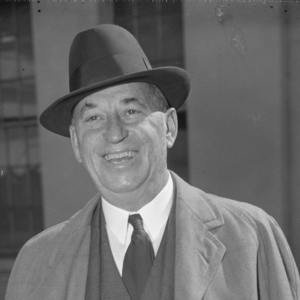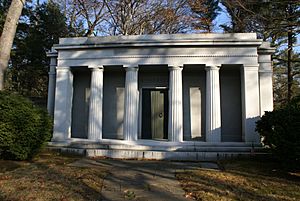Walter Chrysler facts for kids
Quick facts for kids
Walter Chrysler
|
|
|---|---|

Chrysler in 1937
|
|
| Born |
Walter Percy Chrysler
April 2, 1875 Wamego, Kansas, U.S.
|
| Died | August 18, 1940 (aged 65) Kings Point, New York, U.S.
|
| Resting place | Sleepy Hollow Cemetery |
| Nationality | American |
| Alma mater | International Correspondence Schools in Scranton, PA (presently Penn Foster Education) |
| Occupation | Machinist, manager, entrepreneur |
| Known for | Founding Chrysler Corporation |
| Board member of | Chrysler Corporation |
| Spouse(s) | Della Viola Forker (died 1938 at age 58) |
| Children | 4, including Walter Percy Jr. |
Walter Percy Chrysler (born April 2, 1875 – died August 18, 1940) was a very important person in the American car industry. He was the founder of the famous Chrysler Corporation, which is now part of a bigger company called Stellantis.
Contents
Early Life and Learning
Walter Chrysler was born in Wamego, Kansas. His parents were Anna Maria and Henry Chrysler. He grew up in Ellis, Kansas, and you can even visit his childhood home there, which is now a museum! His father was born in Canada and moved to the United States.
Walter started his career as a machinist and railroad mechanic in Ellis. He was a Freemason, which is a member of a social organization. He learned a lot by taking special courses through the mail from International Correspondence Schools. This helped him earn a degree in mechanical engineering.
Working on the Railroad
Walter began learning his trade in railroad shops in Ellis, becoming a machinist and mechanic. For several years, he traveled around the western U.S., working for different railroads. He became known for being great at fixing engine parts called valves.
He moved often, living in places like Wellington, Kansas, Denver, Colorado, and Cheyenne, Wyoming. Sometimes he moved because he was restless or had a quick temper, but it also helped him learn more about railroads. He worked his way up to important jobs like foreman and general master mechanic.
From 1905 to 1906, Chrysler worked for the Fort Worth and Denver Railway in Childress, Texas. He also lived and worked in Oelwein, Iowa, where there is now a small park dedicated to him.
The highest point in his railroad career was in Pittsburgh, Pennsylvania. There, he became the works manager for the Allegheny locomotive shops of the American Locomotive Company (Alco).
Starting in the Car Business
Walter Chrysler's journey into the car world began in 1911. A banker named James J. Storrow, who was also a director at Alco, asked him if he had ever thought about making cars. Walter was very interested, as he had loved cars for five years already.
Storrow set up a meeting with Charles Warren Nash, who was the president of the Buick Motor Company. Nash was looking for a smart person to lead production. Walter left his railroad job to become the works manager at Buick in Flint, Michigan. He found many ways to make cars cheaper to build. For example, he stopped finishing the hidden parts under the car with the same fancy quality as the visible body.
In 1916, William C. Durant, who started General Motors, took back control of GM from bankers. Walter Chrysler had close ties to these bankers, so he offered to resign.
Durant quickly traveled to Flint to convince Walter to stay at Buick. Durant offered him an amazing salary of $10,000 a month for three years, plus a $500,000 bonus each year, or $500,000 in company stock. Walter would also report directly to Durant and have complete control over Buick. Walter was surprised but accepted the offer right away.

Walter successfully ran Buick for three more years. After his contract ended in 1919, he left his job as president of Buick because he didn't agree with Durant's plans for General Motors. Durant paid Walter $10 million for his GM stock. Walter had started at Buick in 1911 earning $6,000 a year, and he left as one of the richest men in America.
After leaving Buick, bankers hired Walter to help turn around the struggling Willys-Overland Motor Company in Toledo, Ohio. He asked for, and received, an incredible salary of $1 million a year for two years. In 1921, Walter left Willys and bought a controlling share in another struggling company, the Maxwell Motor Company.
Walter gradually stopped making Maxwell cars and brought the company into his new firm, the Chrysler Corporation, in Detroit, Michigan, in 1925. Besides his own car company, he also created the Plymouth and DeSoto car brands. In 1928, he bought Dodge Brothers and renamed it Dodge. That same year, he helped pay for the building of the famous Chrysler Building in New York City, which was finished in 1930. Walter Chrysler was named Time magazine's Man of the Year in 1928.
He was honored by being added to the Automotive Hall of Fame in 1967.
Later Life
In 1923, Walter Chrysler bought a large waterfront estate in Kings Point, New York, on Long Island, New York. He named it 'Forker House'. Later, in 1941, this property was sold to the U.S. government and became part of the United States Merchant Marine Academy.
Walter also built a country estate in Warrenton, Virginia, an area known for horses. In 1934, he bought and restored a famous resort and spa there called Fauquier White Sulphur Springs Company. This property was sold in 1953 and is now a country club.
On the estate he left to his son, Walter P. Chrysler Jr. started a horse breeding farm called North Wales Stud. His son was part of a group that bought a famous racehorse named Bahram in 1940.
Walter Chrysler turned 61 in 1936 and decided to step back from running the company every day. Two years later, his wife, Della, passed away at age 58. Walter was very sad about losing his childhood sweetheart, and his health began to decline. He suffered a stroke and passed away in August 1940 at his home in Kings Point, New York. He was buried at Sleepy Hollow Cemetery in Sleepy Hollow, New York.
See also
 In Spanish: Walter Percy Chrysler para niños
In Spanish: Walter Percy Chrysler para niños


